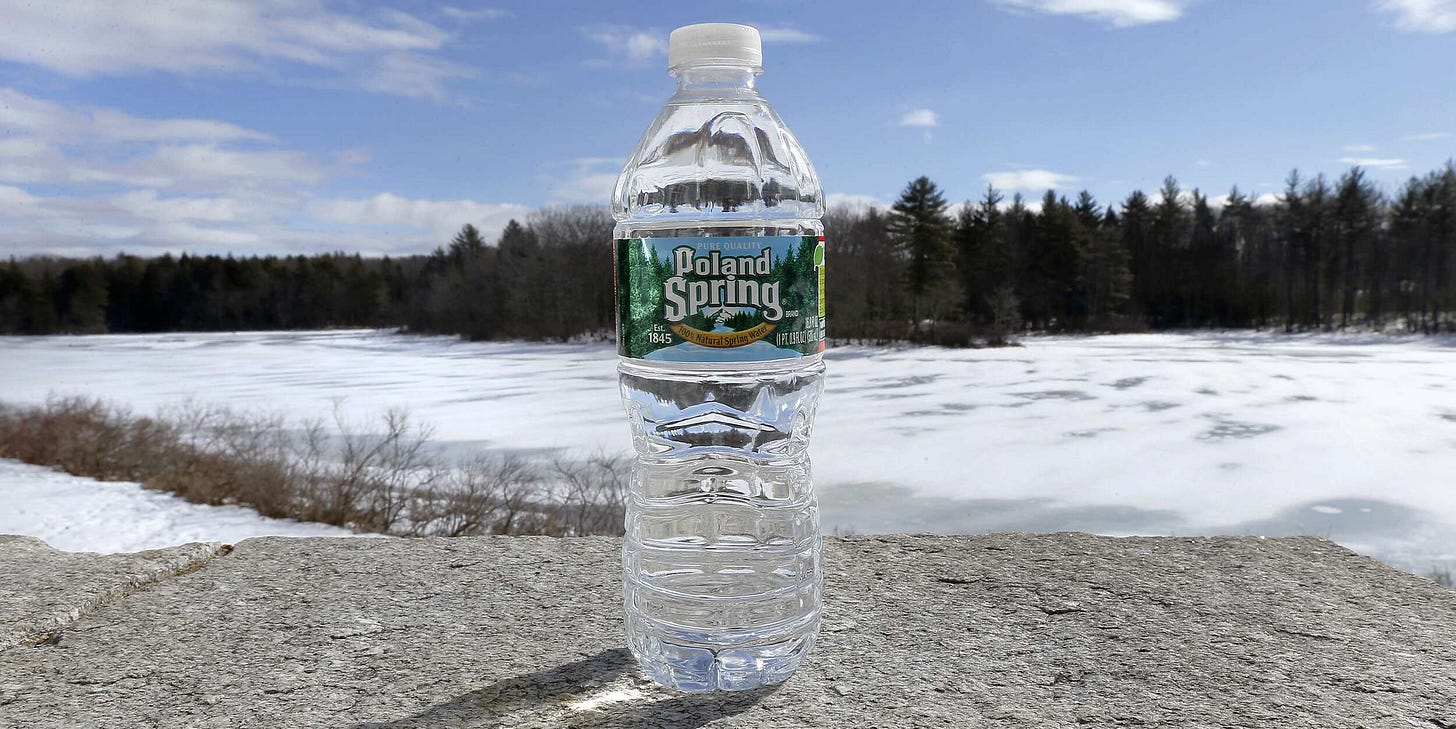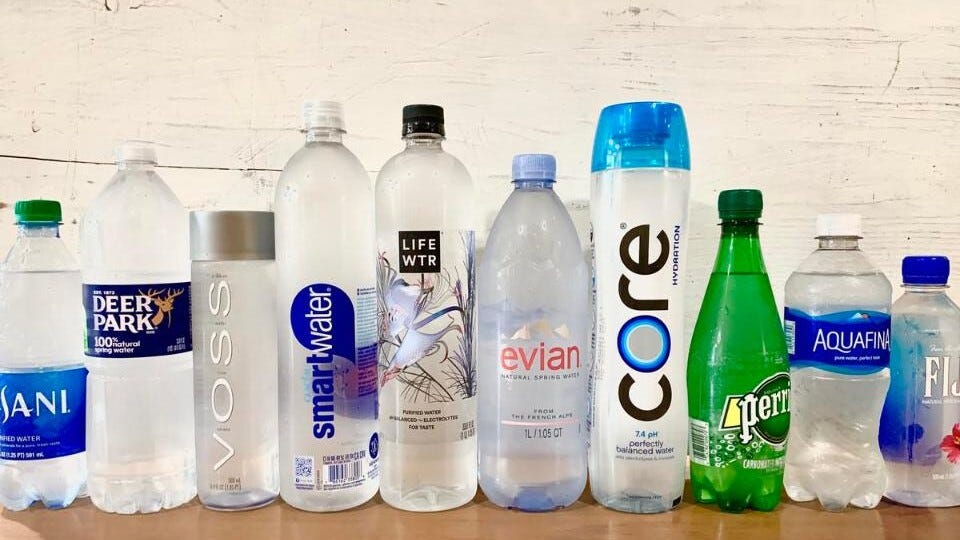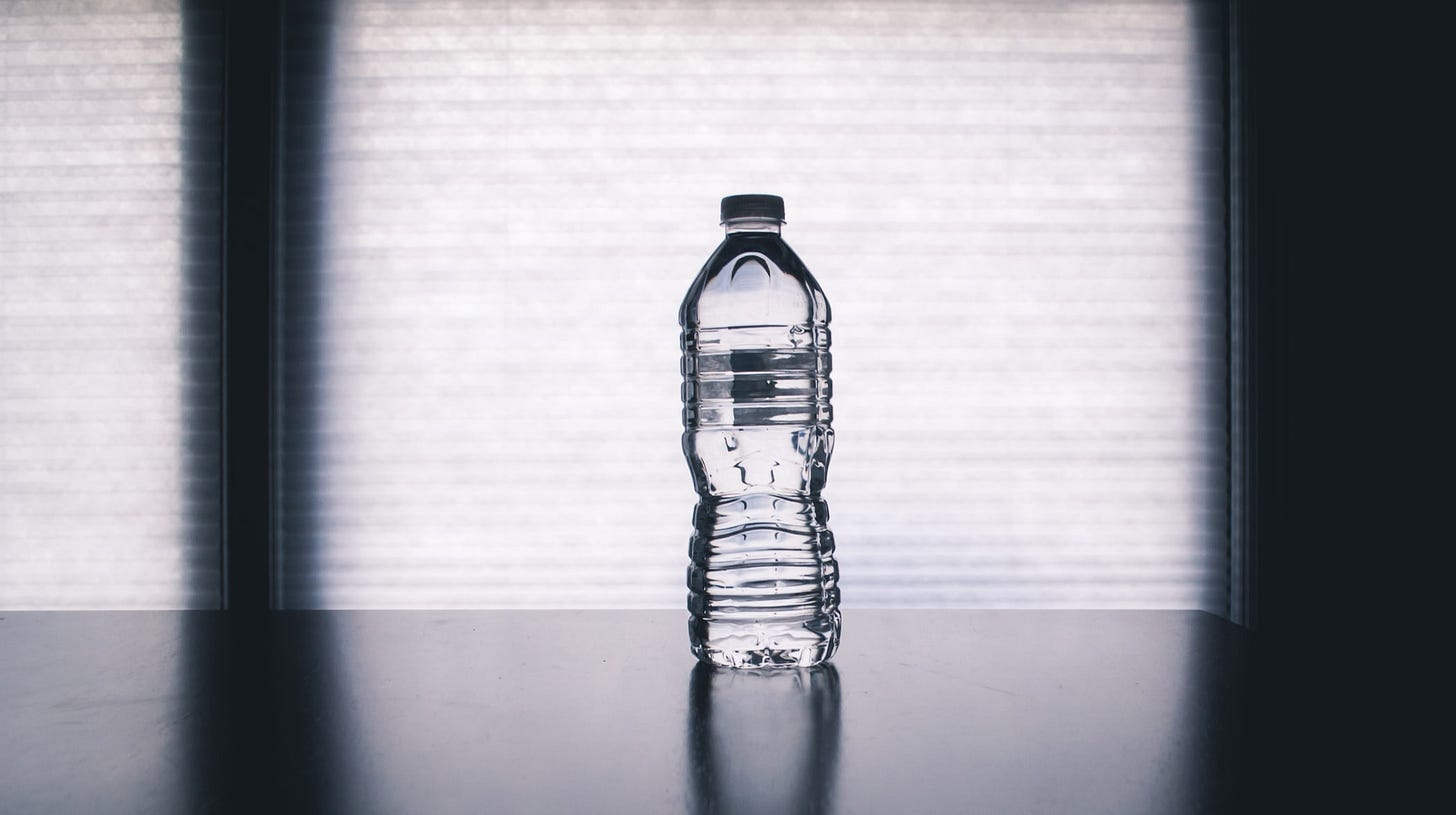Why Are We Obsessed with Fancy Water Brands?
We spend thousands of dollars on a product that is essentially available for free - why are we so seduced by fancy water brands?
A few weeks back, I was sitting in a fireside chat at work where we all had to go around and say a fun fact about ourselves.
Mine wasn’t quite the pulitzer prize worthy anecdote but it was something I had suddenly realized earlier that week: I had managed to hit fifteen different sparkling water brands during the pandemic.
My name got called, I proudly announced my obnoxious over-consumption of carbonated water, and sat down, quickly forgotten amongst my more compelling successors.
But, to my delight, I did get pressed later on about this strange pandemic achievement. Favorite rankings, methods for deciding on a new brand and a common recurring question: Why?
It was a good question.
It’s all to quench thirst and stay hydrated, right? Why spend so much money on drinking something you could essentially drink every day from the tap?
Minus the general boredom of the pandemic, I could atleast justify my curiosity with the variety of exciting brands and flavors in the sparkling water market.
But it brought me to another question: What about regular water brands?
La Croix, Bubly, Ugly Drinks, and Hint all have different flavor palettes and distinct selling propositions - but is there really a big difference between Dasani, Smartwater, and Evian? Isn’t it all just water?
I threw out this poll on my Twitter yesterday that got close to 300 responses.
The results were actually a bit stunning.
A majority of people would either pay extra for bottled water or were not brand sensitive at all. The middle ground got the least love.
It got even more intense in the comments section…
People threw out their brand preferences, built a camaraderie around brand opposition (had no idea people despised Dasani?) and generally had strong opinions on water.
It begs the question - if all water is the same, why do some of us love fancier water?
What do the companies who mass produce bottled water do right?
You’ve probably seen the commercials and the labels - words like alkaline, pure, and natural. Sourced from the Hawaiian islands and filtered through reverse osmosis. Infused with charcoal, boiled in carbon residue, and mixed in with the piss of Jesus.
Does any of this actually work on us?
My rabbit hole brought me into a number of domains: the history of industrial bottled water, the psychology behind our consumption and, of course, the consistently compelling logic behind brands and emotional associations.
Let’s dive into the deep end… of drinking water.
Where Did Bottled Water Even Start?
As you might have guessed, we didn’t wake up one day as a civilization and have fights on the internet over Dasani. But, interestingly enough, the birth of bottled water started from a lot of the same psychology that drives us to bottled water today.
The earliest record instance of bottled water actually comes from England. In 1622, water bottling was recorded in the slopes of the Malvern Hills near England’s Malvern district, largely believed to be the oldest bottling plant in the world.
Water from a well in Malvern came to be known as the Holy Well, namely for the rumor that drinking that water specifically was therapeutic. Bottled water quickly became a status symbol amongst the early wealthy elites of the 17th and 18th centuries - people would claim that natural springs and spas carried water could cure many common diseases of the time.
English physician John Wall (no relation to the basketball player who lost to the Celtics back in 2017) once published a report in 1756 that the Mavern water contained no mineral benefits at all - despite this, he still helped improve facilities in Mavern and continued bottling it knowing that people, quite literally, did not give a shit.
This is basically marketing 101!
One of the more dramatic instances came in 1844 when the grandson of an innkeeper at the Wentworth Ricker Inn claimed that the spring water from the inn’s property cured him of chronic indigestion. The family quickly discovered this could have commercial value and started bottling it immediately, renaming the inn to something we’re a bit more familiar with today in 1876: The Poland Spring House. It became a mainstay of the wealthy elites in New England.
Yes, Poland Spring also was born from what is largely an anecdotal medical claim.
Keep in mind, these were all rich people doing rich people things. Many of the average city dwellers in the 19th century were forced to drink municipal water, subjected to diseases like cholera, typhoid and dysentery from its bacteria.
When water chlorination began in 1905, this changed: municipal water was purified and installed in drinking water systems around the world. It was a sad day for rich people - they now basically had to drink the same water as everyone else.
For a while, nothing really happened in America. People were fine drinking municipal water, generally trusting of the water treatment plants.
But three turning points came in the 1970s and 1980s:
First, Dupont Engineer Nathaniel Wyeth patented polyethylene terephthalate (PET) bottles, plastic bottles that could replace glass and withstand the pressure of carbonated liquids. They were lighter, easier to carry around, and people no longer had to mess with glass. Win win!
Second was a report that came out by the EPA in 1986 showing that tap water used by Americans contained high amounts of lead, mentioning how lead accounts for lower intelligence, high rates of hypertension, heart attacks and more. Naturally, people freaked out. While cites rushed to fix the problem, much of the mistrust from that report lingered. People were scared to drink water in their own home.
Third, European bottled water companies doubled down on their marketing to the American market. French sparkling water company Perrier hired Orson Welles to do some ads touting their water. He called it “more quenching, more refreshing” and sounded seductive as hell doing it. The ever so susceptible Americans were sold.
While all these are important, the third one is particularly compelling, largely because of how successful Perrier was at saying… well effectively, nothing.
It presented Perrier as water that came directly from the center of the Earth.
What does that mean? Who cares!
By 1978, Perrier was predicting sales of 75 million bottles. It even began sponsoring events like the New York City Marathon, to continue its image as one of health.
Perrier’s model quickly became a catalyst for other fancy water brands. Evian and Vittel in France escalated their branding, each trying to aim for a different image. Evian presented itself as a utility of every day use and Vittel focused on the idea of vitality. How you could live so much better and longer with Vittel.
In the 1990s, big companies in the US like Coca Cola and Pepsi started to see the impact of these weirdly seductive ads at the expense of their own products. People didn’t want to drink soda anymore - they wanted these beautiful natural hydrants.
They both made their own moves with a twist: they had built in purification systems that didn’t require them to go to these springs and natural aquifers. They could source from municipal tap water. These brands launched Aquafina (Pepsi) and Dasani (Coke) respectively, each gaining market share in the US.
Why spend so much time talking through the history of bottled water?
Because, even as early as the 19th century, so much of bottled water was built around image. From the earliest days, springs were thought to carry medicinal properties. Single anecdotes began to drive placebos at scale.
But even now, people are adamant about selecting their different water brands, even though these brands are probably… roughly the same?
Why does marketing work so well for something as simple as water?
Why Do We Choose Certain Water?
In the Journal of Environmental Protection, the authors of a white paper discussing the influence of tap and bottled water called bottled water one of “capitalism’s greatest mysteries” - why do we package and sell something that is largely freely available?
Two theories I have rest on things I’ve written about in the past.
One is the concept of the Health Halo Effect that I wrote about in my piece for food. When brands choose the right buzzwords, you start to actually believe things are better for you.
Take alkanity and PH level. Journalist Kristina Rodulfo tried ten different fancy water brands that all touted alkaline and high PH level.
For context, good water is usually around 7. Any more than 7 means it’s very basic, a.k.a you if you don’t subscribe to this newsletter.
Essentially, alkaline water means water that is over a PH of 7. Why? Well if 7 is good water, then alkaline water must be the most fucking amazing thing in the world.
Rodulfo turned to a dietician, Dr. Charles Mueller, to ask the question we’re all wondering: “Does alkaline actually matter?”
Dr. Mueller dropped a nice little bombshell: “The changes in pH in water have absolutely no bearing or effect on the much more radical changes in pH that naturally exist in your stomach and duodenum. They’re meaningless.”
No! You don’t say!
Well, anyway, as we saw with food, words are powerful. Alkaline has made its way into the lexicon as some sort of status symbol.
If you look at the Quora threads about what makes Fiji Water special, people talk about the fact that Fiji Water has a PH level of 8, no heavy metals and no electrolytes.
We’ve already learned, PH level is only marginally useful. Still, the health halo wins. (Electrolytes is a funny one too. Outside of situations where you’re ill or exposed to heat, there is no benefit of additional electrolytes to daily hydration needs.)
Another interesting connection is somatic markers, which I talked about with Coors Light a few months back. Somatic markers are brain shortcuts that help us emotionally associate brands with experiences. Take “Evian” for example - the simple image of the mountains evokes a sense of cool and refreshing memories. It feels like you’re drinking out of some naturally untethered pool. Despite the fact that it could have largely the same effects as any other water below, our brain processes the branding differently.
Perrier is another great example of somatic markers at work. Michael Bellas, chairman of the Beverage Marketing Corporation, mentions how Perrier almost became a badge of sorts. “When you held a Perrier bottle up, it said something about yourself, it said you were sophisticated, you … understood what was happening in the world."
Continuing this logic, many seemingly random water brands have surrounded themselves with cults.
Andrea Hernandez from the Snaxshot talks about how water, like many other brands, has its own niche subsects. Topo Chico, La Croix, and brands like Pricklee are targeting water to very specific consumers.
She also mentions how the modern internet art of nonsensical marketing has catapulted brands like Liquid Death to insane valuations. Liquid Death is a brand targeted to “punk crowds” that hate alcohol and drugs with the tagline to “murder your thirst”. What does that mean? Who even knows. I’ve been thirsty before with no desire to murder anything, I guess I can’t speak for the punk rockers on the outskirts of the bottled water market.
But it’s a brain shortcut - if you truly believe that this is the water meant for you and will make you cooler as a punk rock enthusiast, who even cares what’s in it?
There’s one more interesting theory of why branding works so well for water and it’s a theory developed by researchers at the University of Waterloo - we choose certain water brands because our deep, intrinsic desire for immortality.
Sarah Wolfe, one of these researchers talks about our water decisions through the lens of something called the terror management theory.
According to Wolfe, the theory holds that the unique human emotion of fear is so profound that we almost subconsciously make decisions from a self-preservation instinct.
Think back to the slogans of popular water brands. Dasani, can’t live without it. Vittel, a new life everyday. Evian, the secret is in the alps. All words that ascribe immortality.
Of course this works on some of us - water is something we drink everyday. The smallest shift or skepticism around water supply will make us fear for our lives.
Is it a rational fear? Some would certainly say yes. But regardless, it’s less important whether or not it’s rational - it works.
Final Thoughts
While the macro-level psychology here certainly is fascinating, there’s one thing I haven’t quite touched on: the idea of self-image that comes purely from any bottled water, agnostic of brand.
In a study at the UC Business School in New Zealand, researchers explored consumption motivations for consumers who chose to buy bottled water and found five main themes as to why people purchase: 1) Health, 2) The bottle, 3) Convenience, 4) Taste, and 5) Self-Image.
We’ve talked a lot about health and taste. Convenience is the more obvious theme. The other two, the bottle and self-image, are interesting.
These are all real quotes from the study: I bought the Evian water because the bottle looks cool. If I bought a reusable water bottle, I would feel like a real cheapskate, and it would be embarrassing, and I wouldn’t fill it up.
Don’t they sound somewhat snobby? Look in a mirror, that’s literally all of us.
At the end of the day, this is only the surface around the confusing psychology of drinking water. I didn’t even begin to skim the tap water psychology or the neutralization techniques people use to ignore the environmental impact of bottled water, which is its own conundrum.
When I think of my own preferences, I have to say I do like Smartwater. Why? The bottle is cool. It’s distilled water with electrolytes. It has the word glaceau on it, which invokes the image of a glacier. I’ve probably used one of those excuses at any point before. I’m basically a walking caricature of my own research.
If anything, it does make me feel better. Just like the hundreds of you who proudly proclaimed on that twitter poll that brand is important to you, I’m also the same.
But now you can sleep at night with the comfort that even if you think your bottled water is somehow magically superior to every other brand, you’re basically just as sane as I am.








